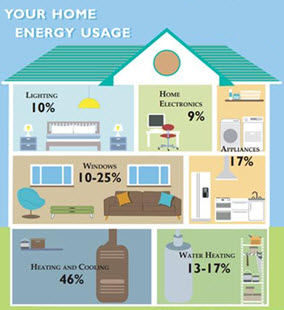Energy and utility usage is among the criteria used by prospective tenants when making a rental home decision. In vacation rentals or homes where owners keep utilities in their own name, monthly utility bills are one of a property owner's single biggest expenses! Improving your property's efficiency on energy and water consumption will not only make it more attractive to prospective tenants but will add significant resale value in the event you someday plan to sell the property.
Here are several utility consumption improvements that ultimately pay for themselves:
Install a Drip System: Do you know that companies charge twice for the water used every month -- once to pump it into the house and again to pump it out as sewage? Water company logic is that every gallon of water that you run out of your faucet is going to go back down the drain. But if you use water to irrigate your lawn or garden, that water never makes it into the sewer system. So, with a drip or mesh system in your yard you not only reduce water consumption but also save on sewer charges. Especially in today's drought conditions in Southern California, drip systems are the right thing to do!
Smart Home Products: Smart home products are the new rage, especially when integrated into WiFi enabled devices such as Amazon Alexa and Echo. From a cell phone or with a simple Alexa command, many items in a home can be controlled to turn on/off, up/down, or open/ shut including lights, fans, TVs, switches, thermostats, garage doors, sprinklers, locks, security systems and more. Smart thermostats such as those from Next learn a residents’ behavior on their own and adjust accordingly to save between 10–12% on heating and 15% on cooling each year. If you don't have one now, a programmable or smart thermostat can play this role for your home automatically.
Energy Star Products: You've probably heard of Energy Star, the partnership between the EPA and the U.S. Department of Energy that identifies energy-efficient products. Energy Star ratings are seen on large appliance items like water heaters and clothes dryers but also on relatively inexpensive items utilized throughout a home. LED light bulbs, for example, are a simple way to save real money on energy. The EPA provides the Energy Star label only when the device is tested and determined recoup the investment with subsequent power or water savings within a 5 year horizon.
Motion Sensor Light Switches: These handy little devices are quite simple in nature. Simply install them where your regular light switch goes and they’ll automatically turn off lights on the line when no motion is detected. Similarly, the lights will switch back on when the resident walks into the room. This is particularly handy when returning to the home with grocery bags in both hands!
Hibernation or Time-Out Features on Electronics: Hibernate feature in laptops and desktops allows saving of existing work and also electricity! Even TVs, home theater amplifiers, set top and cable boxes, PlayStations, and the like will consume energy when not in sleep mode. This type of idle power usage is known as "phantom energy". It occurs when electricity is used even when equipment is turned off. Phantom energy is not insignificant - according to some experts it can account for as much as 15% of the total energy consumption of an electronic device! The best way to avoid phantom energy consumption is to put all devices on a switched line or power strip ... all devices can then be turned completely off with one flip of the switch.
Low-flow shower heads: These only cost about $40 and can be installed throughout your home. Save an estimated $250 per year for each traditional shower head replaced!
Window Weatherstrip, Caulk, and Seal: Replacing old, drafty, single pain windows isn't cheap (about $4000 to install 8 mid-level windows), but you'll save up to $465 per year for each 2000 ft.2 area—while increasing the property's value. Another lower cost alternative is to simply have a handyman check all windows for drafts and small openings on seals and points of closure. Inexpensive weatherstripping, expanding foam or caulk can be easily used to seal cracks around windows and door frames where heat or cool are may escape from your home.
Solar panels: State and federal subsidies have drastically reduced the cost of solar panels. They're a big upfront investment; but with subsidies and cost savings, they can be paid off in as little as 4 years.
NCPG works with our clients to assist in getting estimates on utility consumption saving devices or appliances in their homes. One of our staff members is always available to to discuss what is best for a home and recommend an energy vendor to meet a property owner needs!
Follow North County Property Group on our Blog, Facebook , Twitter, Y
Contact us today: 1-800-436-2235 / info@ncpropertygroup.com











